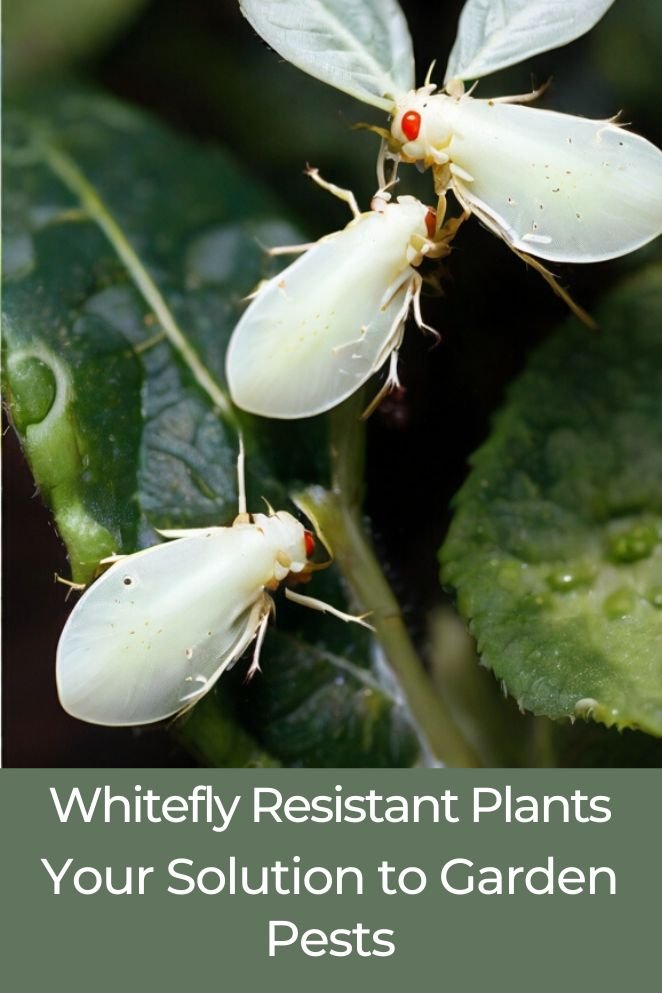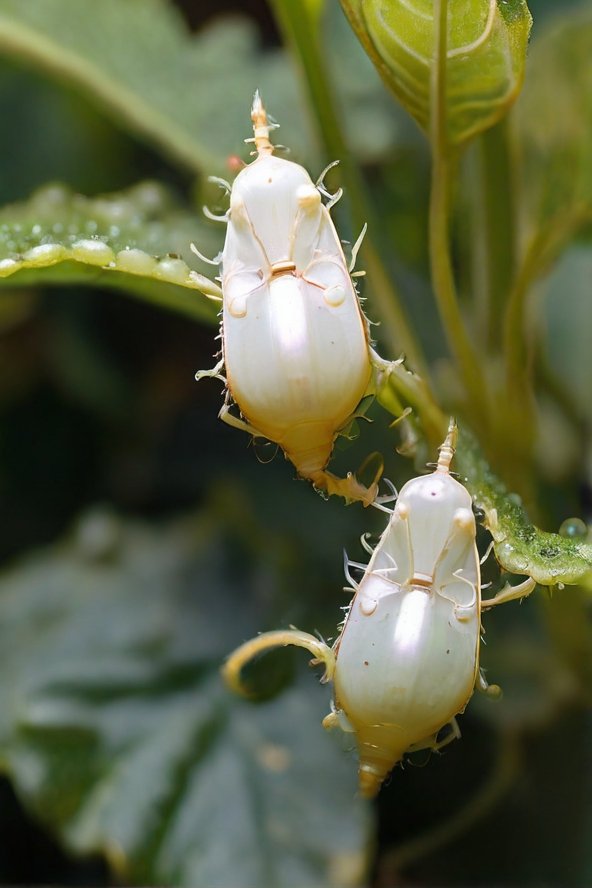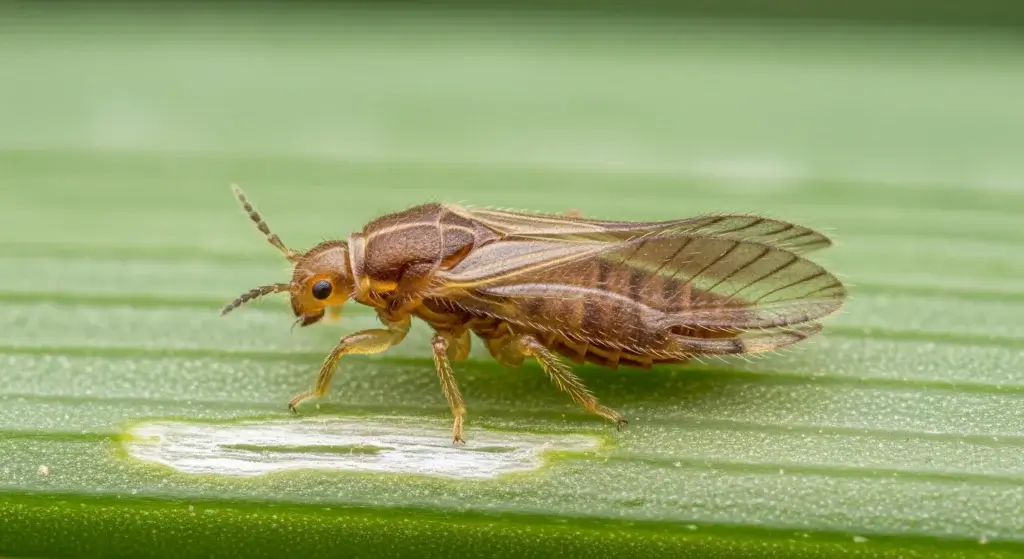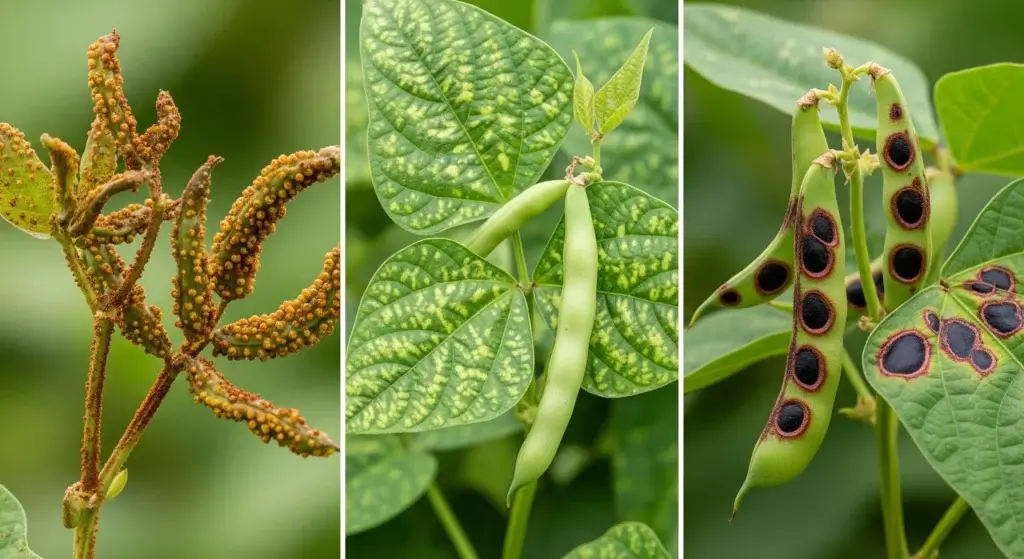
Whiteflies are a common pest that can wreak havoc on plants, causing damage and reducing yields.
While there are many ways to control whiteflies, one effective method is to use whitefly-resistant plants.
In this article, we’ll explore the benefits of using whitefly-resistant plants, common signs of whitefly infestation, and how to integrate companion plants effectively.
Common signs of whitefly infestation
Whiteflies are small, winged insects that feed on the sap of plants.
They are often found on the undersides of leaves and can cause damage by sucking out plant juices and transmitting viruses.
Here are some common signs of whitefly infestation:
- Yellowing leaves: Whiteflies can cause leaves to turn yellow and eventually die off.
- Sticky residue: Whiteflies excrete a sticky substance called honeydew, which can attract ants and other pests.
- Stunted growth: Plants infested with whiteflies may experience stunted growth and reduced yields.
- Whitefly presence: Whiteflies themselves are small, white insects that can be seen on the undersides of leaves.
Whitefly-Resistant Plants
Using whitefly-resistant plants is an effective way to control whitefly infestations.
Here are some examples of plants that are known to be resistant to whiteflies:
- Read also: Ladybugs for Garden Pest Control
- Read also: A Guide to Organic Whitefly Control
Flowers

Marigolds
Marigolds, with their bright and cheerful blooms, are not just a visual delight but also effective at repelling whiteflies.
These flowers emit a scent that acts as a natural deterrent, making them an excellent choice for both ornamental and practical garden spaces.
Consider planting marigolds as borders or companion plants to safeguard neighboring vegetation.
Specific characteristics
| Flower | Marigolds |
| Scientific Name | Tagetes spp. |
| Characteristics Against Whiteflies | Emit a scent that acts as a natural whitefly deterrent. Ideal for borders and companion planting. |
Nasturtiums
Nasturtiums, with their distinctively shaped leaves and vibrant blossoms, offer dual benefits in the garden.
Not only are they visually appealing, but they also possess properties that repel whiteflies.
These versatile plants can be grown in both beds and containers, making them a valuable addition to any garden looking to ward off unwanted pests.
Specific characteristics
| Flower | Nasturtiums |
| Scientific Name | Tropaeolum majus |
| Characteristics Against Whiteflies | Possess properties that repel whiteflies, making them a versatile choice for both beds and containers. |
Petunias
Known for their cascading blooms and a spectrum of colors, petunias are not just a treat for the eyes but also resilient against whiteflies.
Their robust nature and ability to thrive in various conditions make them a popular choice for gardeners.
Whether in hanging baskets, containers, or flower beds, petunias bring both beauty and pest resistance to the garden landscape.
Specific characteristics
| Flower | Petunias |
| Scientific Name | Petunia spp. |
| Characteristics Against Whiteflies | Resilient and robust, petunias are known for their ability to thrive in various conditions, making them resistant to whiteflies. |
Lantana
Lantana, with its clusters of small, vibrant flowers, is a hardy option that can withstand the presence of whiteflies.
These plants are not only resistant to pests but also attract butterflies, adding an additional layer of charm to your garden.
Lantana’s ability to thrive in diverse climates further enhances its appeal as a whitefly-resistant choice.
Specific characteristics
| Flower | Lantana |
| Scientific Name | Lantana camara |
| Characteristics Against Whiteflies |
Hardy and resistant to whiteflies, lantana’s vibrant clusters of flowers also attract butterflies, enhancing its appeal.
|
Vegetables

Tomatoes
Tomatoes, with their versatility in the kitchen and vibrant presence in the garden, boast properties that make them unappealing to whiteflies.
These vegetables contain natural compounds that act as deterrents, helping to keep whiteflies at bay.
Growing tomatoes in well-drained soil and providing adequate spacing further contributes to their robustness.
Specific characteristics
| Vegetable | Tomatoes |
| Scientific Name | Solanum lycopersicum |
| Characteristics Against Whiteflies | Contains natural compounds acting as whitefly deterrents. Thrive in well-drained soil and with adequate spacing. |
Peppers
Peppers, whether sweet or hot varieties are excellent choices for a whitefly-resistant garden.
Their pungent compounds not only add flavor to your meals but also discourage whiteflies.
Growing peppers in a sunny location and avoiding overcrowding in the garden promotes optimal growth while minimizing susceptibility to pests.
Specific characteristics
| Vegetable | Peppers |
| Scientific Name | Capsicum spp. |
| Characteristics Against Whiteflies |
Pungent compounds in peppers add flavor to meals and discourage whiteflies. Sunlight and proper spacing promote optimal growth.
|
Eggplants
Eggplants, with their glossy purple skins and mild flavors, are naturally resistant to whiteflies.
These vegetables contain compounds that act as repellents, making them a valuable addition to your pest-resistant garden.
Providing well-balanced soil and regular monitoring for signs of pests enhance the overall health of eggplants.
Specific characteristics
| Vegetable | Eggplants |
| Scientific Name |
Solanum melongena
|
| Characteristics Against Whiteflies |
Naturally resistant to whiteflies with compounds that act as repellents. Flourishes with well-balanced soil and regular monitoring.
|
Okra
Okra, known for its slim, elongated pods, is a resilient vegetable with natural defenses against whiteflies.
Rich in nutrients and adaptable to various climates, okra plants thrive while deterring common garden pests.
Ensuring proper spacing and good air circulation around okra plants aids in preventing whitefly infestations.
Specific characteristics
| Vegetable | Okra |
| Scientific Name |
Abelmoschus esculentus
|
| Characteristics Against Whiteflies |
Resilient vegetable with natural defenses against whiteflies. Thrives in various climates with proper spacing and air circulation.
|
Kale
Kale, a nutrient-packed leafy green, is not only a superfood for humans but also exhibits resistance to whiteflies.
Its robust nature and ability to tolerate cooler temperatures make kale an attractive option for a whitefly-resistant garden.
Regular monitoring and prompt removal of any affected leaves contribute to its overall health.
Specific characteristics
| Vegetable | Kale |
| Scientific Name |
Brassica oleracea
|
| Characteristics Against Whiteflies |
Nutrient-packed leafy green exhibiting resistance to whiteflies. Tolerates cooler temperatures and benefits from regular monitoring.
|
Herbs

Basil
Basil, with its aromatic leaves and diverse varieties, is a powerhouse in the garden. Not only does it enhance the flavor of your culinary creations, but it also possesses natural compounds that act as whitefly deterrents. Planting basil in well-drained soil, ensuring adequate sunlight, and avoiding overwatering contribute to its robust growth and whitefly resistance.
Specific characteristics
| Herb | Basil |
| Scientific Name | Ocimum basilicum |
| Characteristics Against Whiteflies | Aromatic leaves contain natural compounds acting as whitefly deterrents. Thrives in well-drained soil with adequate sunlight. |
Thyme
Thyme, with its delightful fragrance and culinary versatility, is known for its resilience against whiteflies.
This herb releases oils that are unappealing to these pests, making it a valuable addition to your garden.
Thriving in sunny locations with good air circulation, thyme not only enhances your dishes but also fortifies your garden against whitefly infestations.
Specific characteristics
| Herb | Thyme |
| Scientific Name | Thymus vulgaris |
| Characteristics Against Whiteflies |
Releases oils unappealing to whiteflies, making it a resilient herb. Flourishes in sunny locations with good air circulation.
|
Oregano
Oregano, with its bold flavor and aromatic leaves, is a natural whitefly deterrent.
The essential oils in oregano not only add zest to your cooking but also contribute to its pest-resistant properties.
Growing oregano in well-drained soil, providing ample sunlight, and avoiding excessive moisture create an environment where oregano thrives while keeping whiteflies at bay.
Specific characteristics
| Herb | Oregano |
| Scientific Name |
Origanum vulgare
|
| Characteristics Against Whiteflies |
Essential oils in oregano add flavor to dishes while deterring whiteflies. Requires well-drained soil and ample sunlight.
|
Rosemary
Rosemary, with its woody stems and fragrant needles, is a hardy herb known for resisting whiteflies.
The oils released by rosemary plants act as natural repellents, making them an excellent choice for both culinary and ornamental purposes.
Ensure well-drained soil and sunlight exposure to harness the full potential of rosemary’s whitefly-resistant qualities.
Specific characteristics
| Herb | Rosemary |
| Scientific Name |
Rosmarinus officinalis
|
| Characteristics Against Whiteflies |
Woody stems release oils acting as natural repellents against whiteflies. Flourishes in well-drained soil and sunlight exposure.
|
Mint
Mint, with its refreshing aroma and rapid growth, is not only a delightful herb but also a natural whitefly deterrent.
The strong scent emitted by mint plants discourages whiteflies from settling.
Growing mint in containers, as it tends to be invasive, and providing partial shade contribute to its resilience against whiteflies.
Specific characteristics
| Herb | Mint |
| Scientific Name | Mentha spp. |
| Characteristics Against Whiteflies |
The strong scent emitted by mint plants discourages whiteflies. Thrives in containers and benefits from partial shade.
|
Trees & Shrubs

Lavender
Lavender, with its fragrant spikes of flowers, is not only a visual delight but also naturally repels whiteflies.
The aromatic oils in lavender act as a deterrent, making it an excellent addition to gardens and landscapes.
Planting lavender in well-drained soil, providing sufficient sunlight, and ensuring good air circulation contributes to its robust growth and whitefly-resistant properties.
Specific characteristics
| Tree/Shrub | Lavender |
| Scientific Name | Lavandula spp. |
| Characteristics Against Whiteflies | Aromatic oils act as natural whitefly deterrents. Flourishes in well-drained soil with sufficient sunlight. |
Crape myrtle
Crape myrtle, with its vibrant and showy blossoms, is not just a decorative choice but also a tree that withstands whiteflies.
These trees boast a natural resistance that makes them a valuable addition to gardens and yards.
Ensuring proper watering, providing well-drained soil, and regular pruning contribute to crape myrtle’s overall health and whitefly resistance.
Specific characteristics
| Tree/Shrub | Crape Myrtle |
| Scientific Name |
Lagerstroemia spp.
|
| Characteristics Against Whiteflies |
Showy blossoms conceal natural whitefly resistance. Thrives with proper watering, well-drained soil, and regular pruning.
|
Viburnum
Viburnum, with its diverse species and appealing clusters of flowers, is a sturdy shrub that naturally deters whiteflies.
The dense foliage and natural compounds in viburnum make it an attractive and low-maintenance choice for landscaping.
Incorporating viburnum into your outdoor space adds both aesthetic value and a layer of protection against whitefly infestations.
Specific characteristics
| Tree/Shrub | Viburnum |
| Scientific Name | Viburnum spp. |
| Characteristics Against Whiteflies |
Dense foliage and natural compounds make viburnum a low-maintenance, whitefly-resistant shrub. Adds aesthetic value to landscaping.
|
Oleander
Oleander, with its evergreen nature and vibrant blooms, is a hardy shrub known for its whitefly-resistant properties.
These plants feature toxins that naturally deter pests, making them a reliable choice for landscaping.
Oleanders thrive in well-drained soil and are well-suited for various climates, adding both visual appeal and whitefly protection to your outdoor environment.
Specific characteristics
| Tree/Shrub | Oleander |
| Scientific Name |
Nerium oleander
|
| Characteristics Against Whiteflies |
Toxins naturally deter whiteflies. Hardy and well-suited for various climates, providing vibrant blooms and whitefly protection.
|
How to integrate companion plants effectively
Integrating companion plants with whitefly-resistant plants can further enhance their effectiveness.
Companion plants can attract beneficial insects that prey on whiteflies, such as ladybugs and lacewings.
Here are some tips for integrating companion plants effectively:
Choose plants that attract beneficial insects
Opt for companion plants known to attract beneficial insects that are natural predators of whiteflies.
Dill, fennel, and yarrow are excellent choices, as they release fragrances and nectar that lure in beneficial insects such as ladybugs and lacewings.
By strategically placing these plants, you create a welcoming environment for these allies in your fight against whiteflies.
Plant companion plants nearby
Plant companion plants in close proximity to your whitefly-resistant plants to maximize their impact.
By doing so, you create a localized area where beneficial insects can thrive and actively prey on whiteflies.
This proximity enhances the overall effectiveness of your pest control strategy.
Rotate companion plants
Regularly rotating companion plants is a savvy tactic to avoid the accumulation of pests and diseases.
By changing the location of companion plants throughout the growing season, you disrupt the potential establishment of pest colonies.
This practice contributes to a healthier and more resilient garden ecosystem.
Avoid using pesticides
Resist the temptation to use pesticides, as they can harm not only the pests but also the beneficial insects crucial for a balanced ecosystem.
Embrace natural methods such as companion planting and handpicking to maintain a harmonious garden.
This approach preserves the delicate balance between pests and their natural predators, ensuring the long-term health of your plants.

- Read also: Neem Oil for Whitefly
- Read also: Natural Pesticides for Fruit Trees
Conclusion
Using whitefly-resistant plants and integrating companion plants can be an effective way to control whitefly infestations.
By choosing the right plants and implementing effective companion planting strategies, you can reduce the damage caused by whiteflies and promote healthy plant growth.
FAQs
Whiteflies are small, winged insects that feed on the sap of plants and can cause damage by sucking out plant juices and transmitting viruses.
Common signs of whitefly infestation include yellowing leaves, sticky residue, stunted growth, and the presence of whiteflies themselves.
Some examples of whitefly-resistant plants include marigolds, nasturtiums, petunias, basil, and mint.
Companion planting can attract beneficial insects that prey on whiteflies, such as ladybugs and lacewings, and promote a healthy ecosystem.



